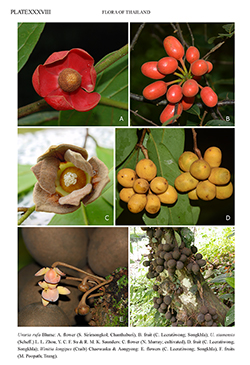e-Flora of Thailand
Volume 16 > Part 1 > Year 2022 > Page 314 > Annonaceae > Uvaria
19. Uvaria siamensis (Scheff.) L.L.Zhou, Y.C.F.Su & R.M.K.Saunderswfo-0000744968
Syst. & Biodivers. 7: 255. 2009.— Rauwenhoffia siamensis Scheff., Ann. Jard. Bot. Buitenzorg 2: 23. 1885; Ridl., Fl. Malay Penins. 1: 89. 1922; Hô, Câyco Viêtnam 1(1): 303. 1991.— Melodorum siamense (Scheff.) Bân, Bot. Zhurn. (Moscow & Leningrad) 39: 241. 1974. Fig. 65. Plate XXXVIII: C–D.
Accepted Name : This is currently accepted.
Synonyms & Citations :
Description : Scandent or erect shrub or tree to 2 m, or climber to 20 m. Young shoots tomentose with large many-branched ferrugineous hairs scattered over smaller, finer, hairs. Leaves thinly coriaceous, waxy above, lanceolate to elliptic, 9–15 by 3–4 cm, base narrowly cordate, apex narrowly to bluntly acute, glabrous except for sparse spreading stellate hairs on midrib above, sub-tomentose with underlying layer of fine ca 6–8 branched hairs overlain with scattered, thickened, many-branched hairs especially on midrib below, secondary veins 8–11(–14) per side; petioles ca 3.5 by 1.25 mm. Inflorescences leaf-opposed or sub-opposed, flowers solitary or rarely 2–3, peduncle rudimentary, ca 1.5 by 1.25 mm, pedicels ca 8 by 1.25 mm. Sepals 3, valvate, free, separating early, very broadly ovate-acute, ca 3 by 6 mm, thickened and remaining incurved. Petals in two whorls of 3, yellow-white, erect at anthesis, fleshy; outer petals broadly ovate, concave, ca 8 by 8 mm; inner petals broadly elliptic with constricted base, ca 8 by 5.5 mm, marginal glands absent. Stamens numerous, cuneate, ca 1.5 mm long, anther locules often unequal in length, anther connective apex flat or shallowly convex, rusty brown or orange with waxy texture, covered with minute blunt papillae, filament short. Carpels ca 10, 3 mm long, ovaries covered with blunt stellate hair-scales giving a very finely warted appearance, neck between ovary and stigma covered with long stellate hairs, stigmas prominent, lobed, U-shaped, hairy, ca 1 mm long, forming distinct dome above stamens, often with copious exudate; ovules ca 4–8, laterally inserted. Monocarps 2–10 (usually 3–6), yellow when mature, globose or short-oblongoid, regular in shape, 1–1.2 by 0.8–0.9 cm, very minutely tubercled, subsessile, the stipe ca 1 mm by 2–3 mm, striate; pericarp thickened and fleshy, but outline of seeds often clear within pericarp in dried specimens. Seeds ca 2–4(–6), compressed hemi-ellipsoid, ca 7 by 4 by 3 mm.
Thailand : NORTHERN: Mae Hong Son, Chiang Mai, Chiang Rai, Lamphun, Sukhothai; NORTH-EASTERN: Sakon Nakhon; EASTERN: Chaiyaphum, Surin, Si Sa Ket, Ubon Ratchathani; SOUTH-WESTERN: Prachuap Khiri Khan; CENTRAL: Saraburi, Nakhom Pathom, Nakhon Nayok; SOUTH-EASTERN: Chon Buri; PENINSULAR: Krabi, Nakhon Si Thammarat, Songkhla, Pattani, Narathiwat.
Distribution : Myanmar, Laos, Cambodia, Vietnam, Peninsular Malaysia, Java (cultivated, from “Siam,” Teijsmann HB. BOG. NO. 17785, holotype -BO, not seen).
Ecology : Disturbed or marginal forests vegetation, particularly in bamboo scrub, up to 300 m alt. Flowering: April–October; fruiting: May–December.
Vernacular : Nom maeo (นมแมว).
Notes: Approximately 50% of collections record Uvaria siamensis as a shrub or small tree. Uvaria siamensis and U. ferruginea have similar flowers, but differ in fruit, leaf and growth habit, whereas U. siamensis and U. hahnii differ in flower structure, but are more similar in fruit and leaf characters.


